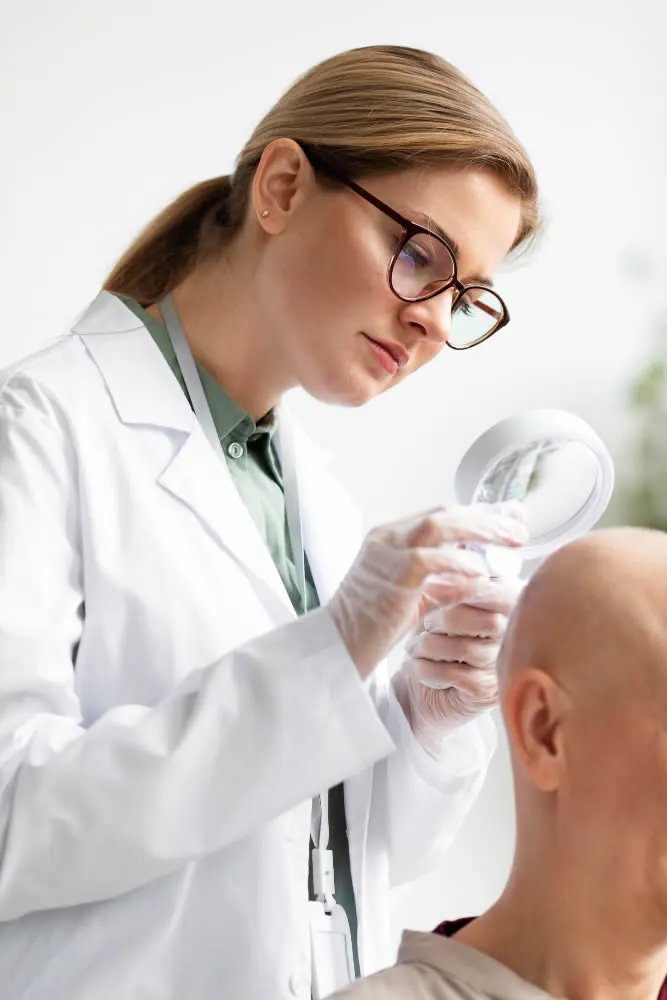What is Melanoma?
Melanoma is a type of skin cancer originating from melanocytes, cells in the skin’s deep epidermal layer. These cells produce melanin, a pigment responsible for skin coloration, which also protects the skin from the harmful ultraviolet (UV) radiation of the sun.
Prolonged exposure to UV radiation can cause sunburn and damage the DNA in skin cells, potentially leading to uncontrolled cell growth and cancer. While melanoma is often associated with sun-exposed areas, it can also develop in moles or even in areas not typically exposed to the sun.
Detecting and treating melanoma early is crucial, as it can be aggressive and life-threatening if left unchecked.

Causes and genetic risk factors of Melanoma
Melanoma, a serious type of skin cancer, primarily from damage to the DNA of skin cells, due to exposure to ultraviolet (UV) radiation from the sun or tanning beds.
DNA damage can lead to uncontrolled cell growth, forming malignant tumors. While UV radiation is a significant environmental risk, genetic can also play a role in melanoma’s development.
Key causes and genetic factors include:
- Ultraviolet (UV) Radiation: Prolonged and intense exposure to UV rays from natural sunlight or artificial sources significantly heightens melanoma risk.
- Moles: Individuals with numerous or atypical moles (dysplastic nevi) are at a higher risk.
- Skin Type: Fair-skinned individuals, especially those with light hair, blue or green eyes, and freckles, are more susceptible due to lower melanin levels, which offers some UV protection.
- Family History: A person’s risk increases if a first-degree relative (parent, sibling, or child) has been diagnosed with melanoma.
- Genetic Mutations: Specific gene mutations, such as those in the BRAF, NRAS, or CDKN2A genes, can predispose individuals to melanoma.
- Previous Cancer Diagnosis: A history of melanoma or other skin cancers elevates the risk for future melanomas.
- Weakened Immune System: Those with compromised immunity due to conditions like HIV/AIDS or treatments like organ transplantation are more vulnerable.
Prevention and regular skin checks are vital, given these risk factors, to detect and treat melanoma at its earliest stages.
Significance of early detection and symptoms
Early detection is important for melanoma, as timely intervention can greatly impact treatment outcomes and overall prognosis.
Detecting melanoma in its initial stages, before it spreads deeper into the skin or to other parts of the body, offers several crucial advantages:
- Improved Treatment Success: Melanoma caught early is often highly treatable with various approaches, including surgical removal.
- Minimized Risk of Metastasis: Early-stage melanomas are less likely to have spread to lymph nodes or distant organs, reducing the risk of metastatic disease.
- Less Invasive Treatments: Smaller, localized melanomas are typically easier to remove surgically, resulting in less extensive procedures and quicker recovery times.
- Preservation of Appearance: Early detection can potentially prevent the need for more extensive surgeries that might impact the appearance of the affected area.
Symptoms and self-Examinations:
Vigilance in self-examination and recognizing potential symptoms are key to early detection. Keep an eye out for the ABCDE characteristics of melanoma:
- Asymmetry: One half of the mole or growth doesn’t match the other half.
- Border: The edges are irregular, ragged, or blurred.
- Color: The color varies within the mole or lesion.
- Diameter: The size is larger than a pencil eraser (about 1/4 inch or 6mm).
- Evolving: Any changes in size, shape, color, or other traits over time.
If any of these characteristics are observed, or if a mole or growth becomes itchy, painful, or starts bleeding, seeking prompt medical attention is crucial. Regular self-examinations, combined with professional dermatological check-ups, play a pivotal role in catching potential melanomas at their earliest, most treatable stages.
How to diagnose Melanoma at different stages?
Diagnosing melanoma involves distinct methods tailored to each stage of the disease.
- Stage 0 (Melanoma In Situ): Diagnosis involves a skin biopsy. A small piece of the suspicious area is removed and examined under a microscope to confirm the presence of abnormal cells.
- Stage I: Tumor size and thickness are assessed through biopsy. If there’s a concern about the cancer’s spread to nearby lymph nodes, a sentinel lymph node biopsy might be performed to determine its involvement.
- Stage II: Biopsy evaluates tumor thickness, ulceration, and mitotic rate. Sometimes, a sentinel lymph node biopsy assesses potential lymph node involvement.
- Stage III: Diagnosis encompasses evaluating regional lymph nodes and nearby skin for cancer spread. Imaging techniques like PET, CT, or MRI help identify distant metastasis.
- Stage IV (Metastatic Melanoma): Diagnosis involves comprehensive imaging scans, including CT, PET, and MRI, to pinpoint the extent of the cancer’s spread. Biopsies of affected organs might be conducted to confirm the presence of melanoma.
Treatment approaches for Melanoma
The treatment path for melanoma depend on the cancer’s stage and the patient’s overall health. Surgery typically is the first option.
Factors like the size and location of the cancer determine the extent of healthy tissue removal. While surgical excision can often be performed under local anesthesia in a dermatologist’s office, more complex cases might require alternative treatments.
Melanoma treatment modalities:
- Melanoma Surgery: In the early stages, surgical intervention holds strong potential for curing melanoma. Dermatologists perform this procedure in-office, numbing the skin with a local anesthetic before excising the melanoma and the surrounding margins of healthy skin.
- Lymphadenectomy: Should melanoma spread, lymph nodes near the initial site of diagnosis might need removal. This preemptive measure can impede the cancer’s dissemination to other body areas.
- Metastasectomy: Targeting small melanoma traces within organs, metastasectomy involves surgical removal to prevent further progression.
- Targeted Cancer Therapy: Focused on specific cancer cells, targeted therapy employs drugs to attack them, sparing healthy cells. This precision approach minimizes collateral damage.
- Radiation Therapy: Employing high-energy rays, radiation therapy targets cancer cells and shrinks tumors, providing a non-surgical avenue for treatment.
- Immunotherapy: This treatment triggers the immune system to effectively combat cancer cells.

FAQs About Melanoma
How common is Melanoma compared to other skin cancers?
While melanoma isn’t the most prevalent form of skin cancer, it is the most lethal. It accounts for a smaller percentage of skin cancer cases but a significant majority of skin cancer deaths.
Is Melanoma more common in certain geographical areas?
Melanoma tends to be more prevalent in areas closer to the equator and at higher altitudes due to increased UV radiation exposure.
Do sunscreen lotions guarantee protection against Melanoma?
While sunscreens significantly reduce UV exposure, they don’t provide complete protection. It’s essential to use them alongside other protective measures like wearing protective clothing and avoiding peak sun hours.
Is there a dermatologist near me in Detroit that offers treatment for Melanoma?
Yes. At our Detroit dermatology office we offers treatment for Melanoma to patients from Detroit and the surrounding area. Contact our office today to schedule an appointment.

